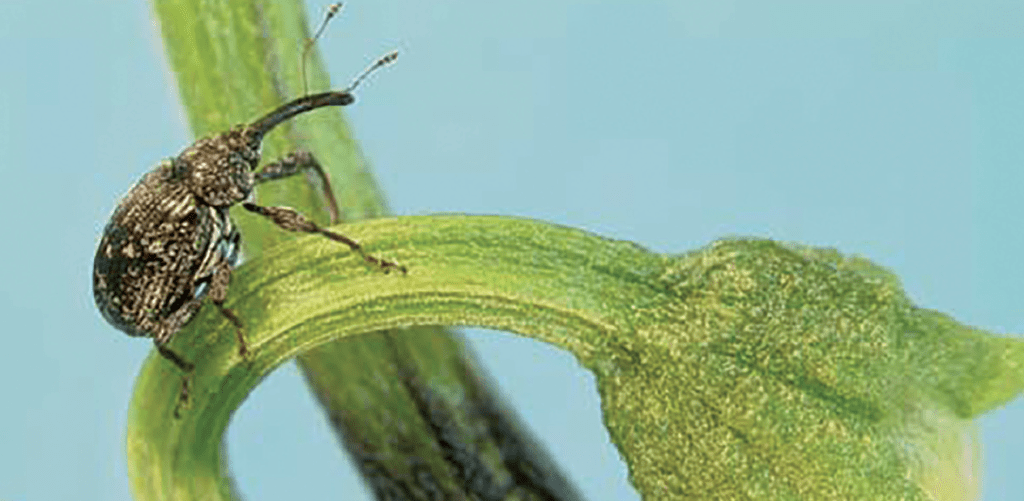
Dec 21, 2020Pepper weevil: Southern pest that can hitch a ride north
Pepper weevils are a devastating pest in the Southern U.S., but larvae concealed inside peppers shipped to Northern markets can carry the pest to Northern growers, too.
New Jersey has been the focal point of the problem and has pepper weevil outbreaks nearly every year – most of them within a mile or two of processors.
“We’re blessed with a number of food processors here,” said Joseph Ingerson-Mahar, senior program coordinator in the Vegetable Integrated Pest Management (IPM) Program at Rutgers University. “We have small communities in south New Jersey and there are farms right up to the community edge,” Ingerson-Mahar said.
That’s where the problem starts. Pepper weevils can fly – from processors in the community to growers’ fields – and the pest can move in other ways, too.
“They seem to have a penchant for riding on vehicles,” Ingerson-Mahar said. “You have a lot of farmers interacting day to day – sharing equipment or simply talking to each other. There are agribusiness firms and Extension staff checking on one farm and then moving to another. You have social services agencies and food vendors going out to the migrant camps. There’s a lot of traffic out there in the fields.”
“The adults are very small – so tiny and so dark you can easily miss them. They’re hard to detect and they’re good hitchhikers,” said Elizabeth Long, assistant professor in Purdue University’s Entomology Department.
Dumping culls and processing waste on fields can introduce pepper weevils. Culls and processing waste left uncovered in a nearby landfill can be a source of pepper weevils. “The weevils can come from anywhere there is waste from a processing plant,” Ingerson-Mahar said.
Adults can also ride to fields in contaminated, produce bins. “If there are weevils hanging around bins that have been taken to the processor, you can infest a field quite easily,” Ingerson-Mahar said. “You can tell in the field where the weevils start. The areas most devoid of any fruit are right near the driveways where vehicles entered to drive bins out into the field.”
Pepper weevil adults will feed on any solanaceae plants but only reproduce on peppers or nightshade and peppers are always preferred. “As they fly around, they will look for peppers,” Long said. “You don’t ever want to plant tomatoes, peppers and eggplants together.” Limiting the amount of solanaceae crops planted near processors can help, too.
Pepper weevil has alternative hosts such as black nightshade, eastern black nightshade and horsenettle so good weed control is important, too.
Adult females lay 200 to 300 eggs each generation in flowers or young fruit causing the flowers and fruit to abort. Weevil larvae continue to develop in aborted fruit and emerge as adults.
The pepper weevil life cycle averages 21 to 30 days. That means if weevils enter a field in early May there’s the potential to have up to six generations in the remaining 20 weeks of the growing season.
The females typically are found in the top one-third of the plant. “The females prefer the youngest part of the plant and that’s where the buds emerge,” Long said.
“You’re losing a lot of yield even with a minor infestation,” Ingerson-Mahar said. “One pepper aborted per 10 feet of row and you’re losing about 4,000 peppers per acre.”
The control strategy developed in New Jersey is to spray an insecticide in high risk fields at first flower to eliminate any weevil adults already present and then deploy pheromone traps. Lower risk fields may not need the initial insecticide application.
Place the pheromone traps at high traffic entry points into the field and at the field borders closest to the possible sources of weevils.
“We recommend putting the traps out early,” Long said. “You want to know where the weevils are coming from. They’re so small, they’re likely to be assisted by the wind and the amount and direction of wind has a big effect.”
“The traps are essentially an early warning system,” Ingerson-Mahar said. “Detect the population before it gets established. Once it’s established, it’s an uphill battle for the rest of the season.”
Fruit on the ground means it’s too late to protect the crop. There may also be infested fruit on the plants with no obvious signs of damage.
Once an infestation has been detected, weekly insecticide applications while rotating chemistries is the strategy and adults are the target. “This is the stage where they can be controlled with insecticides,” Long said. “Typically, if you see a single adult, you spray, and you go in hard.”
“The threshold is one adult,” Ingerson-Mahar agreed. Pepper weevil cannot be effectively controlled once infestations have established and the larvae are inside the peppers.
Aborted fruit on the ground should be removed but that’s nearly an impossible task. “That is a weak link in all of this – removing aborted fruit from the fields,” Ingerson-Mahar said. Detecting and controlling adults before the infestation gets this severe is the best strategy.
Pepper weevils are pre-adapted to take advantage of the current marketing system and the way fresh pepper produce is transported. “In terms of management, pepper weevil should be managed like a plant disease rather than an insect pest that can be controlled with a couple of insecticide applications,” Ingerson-Mahar said.
— Dean Peterson, VGN correspondent














